Influence of Grain Size and Its Distribution on Charpy Impact Properties of TA3 Alloy
Abstract
1. Introduction
2. Experimental
3. Results
3.1. Initial Microstructure
3.2. Mechanical Properties
3.3. Deformed Microstructures
4. Discussion
4.1. Deformation Mechanisms Dependent on Grain Size Distribution and Deformation Rate
4.2. The Reason Why Does FG Ti Sample Exhibit the Lowest Rp0.2 and Highest Elongation at Break during Tensile Deformation?
4.3. The Reason Why Does MG Ti Sample Exhibits the Highest Et during Impact Deformation?
5. Conclusions
- (1)
- TA3 alloy with three different grain size characteristics were produced by combing hot-rolling and annealing treatment, i.e., fine grain size (FG Ti), coarse grain size (CG Ti), and a mixture of coarse and fine grains size (MG Ti). Furthermore, a few retained β phase distributed in CG Ti and the coarse grain region of MG Ti sample.
- (2)
- Among FG Ti, CG Ti, and MG Ti samples, MG Ti exhibits the highest tensile yield strength (Rp0.2) and impact absorbed energy, together with an intermediate tensile elongation to failure (A).
- (3)
- During impact deformation, the primary deformation mode of FG Ti is dislocation slip, whereas the primary deformation modes of MG Ti are dislocation slips in fine grain region and DTs in coarse grain region. For CG Ti, DTs become the primary deformation mode.
- (4)
- The superior combination of tensile strength and impact absorbed energy in MG Ti sample can be ascribed to the couple effect of retained β strengthening and twin inducing plasticity.
Author Contributions
Funding
Institutional Review Board Statement
Informed Consent Statement
Data Availability Statement
Conflicts of Interest
References
- Justin, L.M.; Fadi, A.F.; Cristina, B.; Thomas, K.; Vincent, H.H. Grain refinement and mechanical properties of CP-Ti processed by warm accumulative roll bonding. Mater. Sci. Eng. A 2013, 561, 109–117. [Google Scholar]
- Masoud, A.; Bekir, S.; Bart, J.K.; Yutao, P. The effect of grain refinement on the deformation and cracking resistance in Zn-Al-Mg coatings. Mater. Sci. Eng. A 2022, 840, 142995. [Google Scholar]
- Valiev, R.Z.; Islamgaliev, R.K.; Alexandrov, I.V. Bulk nanostructured materials from severe plastic deformation. Prog. Mater. Sci. 2000, 45, 103–189. [Google Scholar] [CrossRef]
- Wang, B.B.; Xie, G.M.; Wu, L.H.; Xue, P.; Ni, D.R.; Xiao, B.L.; Liu, Y.D.; Ma, Z.Y. Grain size effect on tensile deformation behaviors of pure aluminum. Mater. Sci. Eng. A 2021, 820, 141504. [Google Scholar] [CrossRef]
- Pandey, C.; Giri, A.; Mahapatra, M.M. Effect of normalizing temperature on microstructural stability and mechanical properties of creep strength enhanced ferritic P91 steel. Mater. Sci. Eng. A 2016, 657, 173–184. [Google Scholar] [CrossRef]
- Pandey, C.; Giri, A.; Mahapatra, M.M. Evolution of phases in P91 steel in various heat treatment conditions and their effect on microstructure stability and mechanical properties. Mater. Sci. Eng. A 2016, 664, 58–74. [Google Scholar] [CrossRef]
- Wu, H.; Fan, G.H. An overview of tailoring strain delocalization for strength-ductility synergy. Prog. Mater. Sci. 2020, 113, 100675. [Google Scholar] [CrossRef]
- Fang, T.; Tao, N.R.; Lu, K. Revealing extraordinary intrinsic tensile plasticity in gradient nano-grained copper. Science 2011, 331, 1587–1590. [Google Scholar] [CrossRef]
- Zhao, P.; Chen, B.; Kelleher, J.; Yuan, G.; Guan, B.; Zhang, X.; Tu, S. High-cycle-fatigue induced continuous grain growth in ultrafine-grained titanium. Acta Mater. 2019, 174, 29–42. [Google Scholar] [CrossRef]
- Wang, B.S.; Liu, H.M.; Zhang, Y.G.; Zhou, B.X.; Deng, L.P.; Wang, C.; Chen, J.F.; Zhang, Y.H. Effect of grain size on twinning behavior of pure titanium at room temperature. Mater. Sci. Eng. A 2021, 827, 142060. [Google Scholar] [CrossRef]
- Tsukamoto, G.; Kunieda, T.; Yamasaki, S.; Mitsuhara, M. Nakashima, Effects of temperature and grain size on active twinning systems in commercially pure titanium. J. Alloys Compd. 2021, 884, 161154. [Google Scholar] [CrossRef]
- Zhu, Y.T.; Liao, X.Z.; Wu, X.L. Deformation twinning in nanocrystalline materials. Prog. Mater. Sci. 2012, 57, 1–62. [Google Scholar] [CrossRef]
- He, J.H.; Jin, L.; Wang, F.H.; Dong, S.; Dong, J. Mechanical properties of Mg-8Gd-3Y-0.5Zr alloy with bimodal grain size distributions. J. Magnes. Alloy. 2017, 5, 423–429. [Google Scholar] [CrossRef]
- Jin, Z.Z.; Zha, M.; Yu, Z.Y.; Ma, P.K.; Li, Y.K.; Liu, J.M.; Jia, H.L.; Wang, H.Y. Exploring the Hall-Petch relation and strengthening mechanism of bimodal-grained Mg-Al-Zn alloys. J. Alloys Compd. 2020, 833, 155004. [Google Scholar] [CrossRef]
- Schuh, B.; Pippan, R.; Hohenwarter, A. Tailoring bimodal grain size structures in nanocrystalline compositionally complex alloys to improve ductility. Mater. Sci. Eng. A 2019, 748, 379–385. [Google Scholar] [CrossRef]
- LZhu, L.; Shi, S.Q.; Lu, K.; Lu, J. A statistical model for predicting the mechanical properties of nanostructured metals with bimodal grain size distribution. Acta Mater. 2012, 60, 5762–5772. [Google Scholar]
- Wang, Y.; Chen, M.; Zhou, F.; Ma, E. High tensile ductility in a nanostructured metal. Nature 2002, 419, 912–915. [Google Scholar] [CrossRef]
- Peng, P.; Tang, A.T.; She, J.; Zhang, J.Y.; Zhou, S.B.; Song, K.; Pan, F.S. Significant improvement in yield stress of Mg-Gd-Mn alloy by forming bimodal grain structure. Mater. Sci. Eng. A 2021, 803, 140569. [Google Scholar] [CrossRef]
- Rong, W.; Zhang, Y.; Wu, Y.; Chen, Y.; Sun, M.; Chen, J.; Peng, L. The role of bimodal-grained structure in strengthening tensile strength and decreasing yield asymmetry of Mg-Gd-Zn-Zr alloys. Mater. Sci. Eng. A 2019, 740–741, 262–273. [Google Scholar] [CrossRef]
- Wang, J.; Li, B.; Li, R.; Chen, X.; Zhang, G.J. Bimodal α-Mo grain structure inducing excellent oxidation resistance in Mo-12Si-8.5B alloy at 1100 °C. Int. J. Refract. Met. Hard Mater. 2021, 98, 105533. [Google Scholar] [CrossRef]
- Bach, J.; Stoiber, M.; Schindler, L.; Höppel, H.W.; Göken, M. Deformation mechanisms and strain rate sensitivity of bimodal and ultrafine-grained copper. Acta Mater. 2020, 186, 363–373. [Google Scholar] [CrossRef]
- Flipon, B.; Keller, C.; Garcia, L.; Hug, E.; Barbe, F. Tensile properties of spark plasma sintered AISI 316L stainless steel with unimodal and bimodal grain size distributions. Mater. Sci. Eng. A 2018, 729, 249–256. [Google Scholar] [CrossRef]
- Li, Y.; Lu, Y.F.; Li, W.; Khedr, M.; Liu, H.B.; Jin, X.J. Hierarchical microstructure design of a bimodal grained twinning-induced plasticity steel with excellent cryogenic mechanical properties. Acta Mater. 2018, 158, 79–94. [Google Scholar] [CrossRef]
- Wang, B.J.; Xu, D.K.; Sheng, L.Y.; Han, E.H.; Sun, J. Deformation and fracture mechanisms of an annealing-tailored “bimodal” grain-structured Mg alloy. J. Mater. Sci. Technol. 2019, 35, 2423–2429. [Google Scholar] [CrossRef]
- Guo, M.X.; Zhu, J.; Zhang, Y.; Li, G.J.; Lin, T.; Zhang, J.S.; Zhuang, L.Z. The formation of bimodal grain size distribution in Al-Mg-Si-Cu alloy and its effect on the formability. Mater. Charact. 2017, 132, 248–259. [Google Scholar] [CrossRef]
- Klimova, M.; Zherebtsov, S.; Salishchev, G.; Semiatin, S.L. Influence of deformation on the Burgers orientation relationship between the α and β phases in Ti-5Al-5Mo-5V-1Cr-1Fe. Mater. Sci. Eng. A 2015, 645, 292–297. [Google Scholar] [CrossRef]
- Zhang, Y.; Xin, R.L.; Guo, B.Q.; Wang, K.; Liu, Q. Influence of alternate grain boundary α on the development of Widmanstätten microstructure in TC21 Ti alloy. Mater. Charact. 2021, 177, 111162. [Google Scholar] [CrossRef]
- Baek, J.H.; Noh, S.; Lee, J.G. Effect of Cr and W contents on Charpy impact properties of Fe-Cr-W oxide dispersion strengthened steels. Mater. Sci. Eng. A 2020, 793, 139855. [Google Scholar] [CrossRef]
- Maruschak, P.O.; Sorochak, A.P.; Vuherer, T.; Prentkovskis, O.; Yasniy, O.P.; Bishchak, R.T. Impact toughness and deformation parameters of fracture of railway axle material. Arab. J. Sci. Eng. 2016, 41, 1647–1655. [Google Scholar] [CrossRef]
- Wang, J.; Zhao, Y.; Zhao, Q.; Lei, C.; Zhou, W.; Zeng, W. Comparison on Impact Toughness of High-Strength Metastable β Titanium Alloy with Bimodal and Lamellar Microstructures. Metals 2022, 12, 271. [Google Scholar] [CrossRef]
- Deng, X.G.; Hui, S.X.; Ye, W.J.; Song, X.Y. Analysis of twinning behavior of pure Ti compressed at different strain rates by Schmid factor. Mater. Sci. Eng. A 2013, 575, 15–20. [Google Scholar] [CrossRef]
- Wang, S.Y.; Zhang, Y.D.; Schuman, C.; Lecomte, J.S.; Zhao, X.; Zuo, L.; Je, M.; Philippe, C. Esling, Study of twinning/detwinning behaviors of Ti by interrupted in situ tensile tests. Acta Mater. 2015, 82, 424–436. [Google Scholar] [CrossRef]
- Zhang, R.F.; Wang, J.; Beyerlein, I.J.; Misra, A.; Germann, T.C. Atomic scale study of nucleation of dislocations from fcc-bcc interfaces. Acta Mater. 2012, 60, 2855. [Google Scholar] [CrossRef]
- Ye, P.; Yao, J.Y.; Wang, B.S.; Liu, H.M.; Deng, L.P.; Wang, C.; Chen, J.F.; Li, Q. A comparative study between {11–22} twinning and {10–12} twinning variant selection mechanisms during uniaxial compression in pure titanium. Mater. Charact. 2020, 162, 110188. [Google Scholar] [CrossRef]
- Li, L.L.; Zhang, Z.J.; Zhang, P.; Yang, J.B.; Zhang, Z.F. Difference in fatigue cracking behaviors of Cu bicrystals with the same component grains but different twin boundaries. Scr. Mater. 2015, 95, 19–22. [Google Scholar] [CrossRef]
- Zheng, X.D.; Zheng, S.J.; Wang, J.; Ma, Y.J.; Wang, H.; Zhou, Y.T.; Shao, X.H.; Zhang, B.; Lei, J.F.; Yang, R.; et al. Twinning and sequential kinking in lamellar Ti-6Al-4V alloy. Acta Mater. 2019, 181, 479–490. [Google Scholar] [CrossRef]
- Zheng, X.D.; Liu, G.S.; Zheng, S.J.; Ma, Y.J.; Yang, R.; Wang, J.; Ma, X.L. {10–12} twinning induced by the interaction between {11–21} twin and β phase in α+β Ti alloys. Acta Mater. 2022, 231, 117900. [Google Scholar] [CrossRef]
- Bosh, N.; Müller, C.; Mozaffari-Jovein, H. Deformation twinning in cp-Ti and its effect on fatigue cracking. Mater. Charact. 2019, 155, 109810. [Google Scholar] [CrossRef]
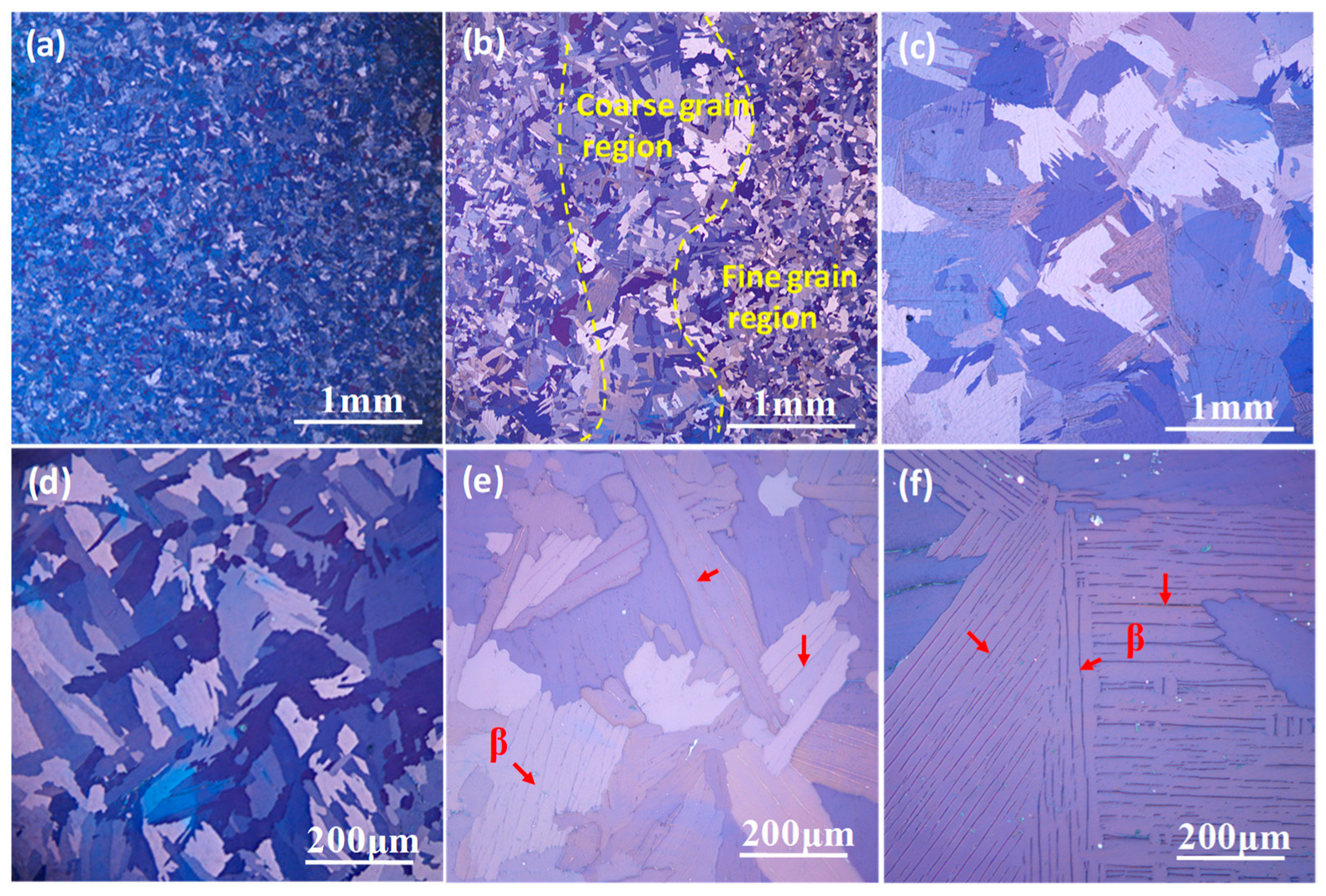
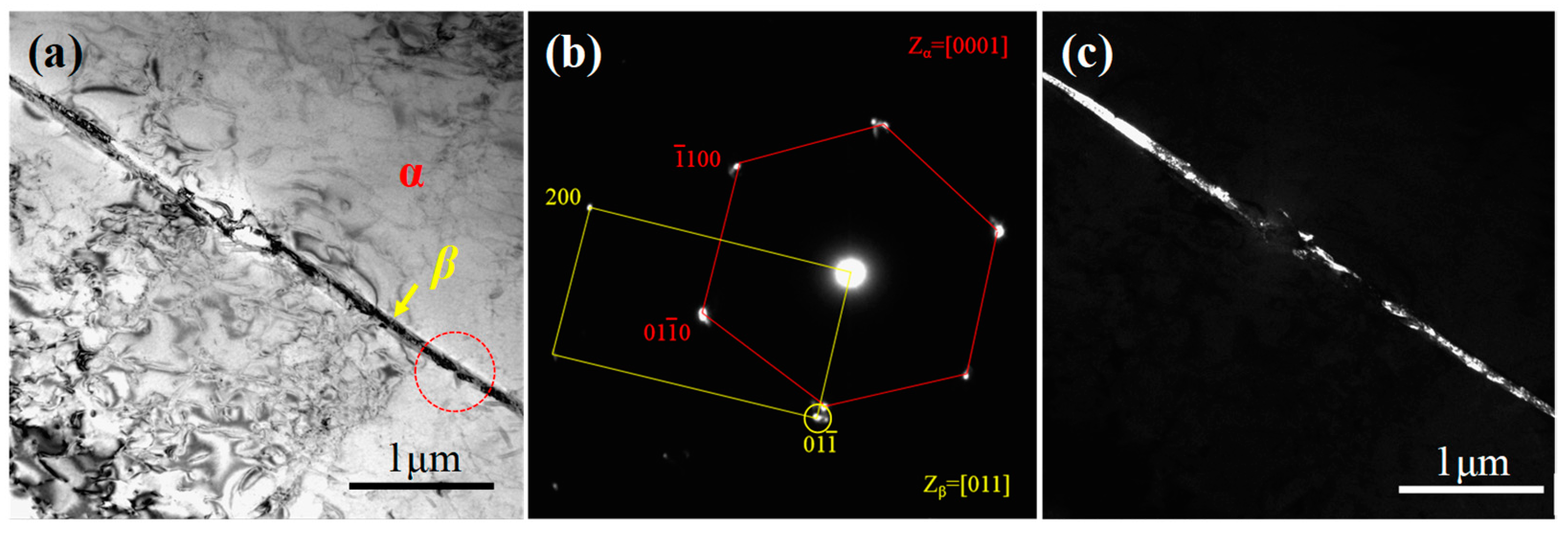



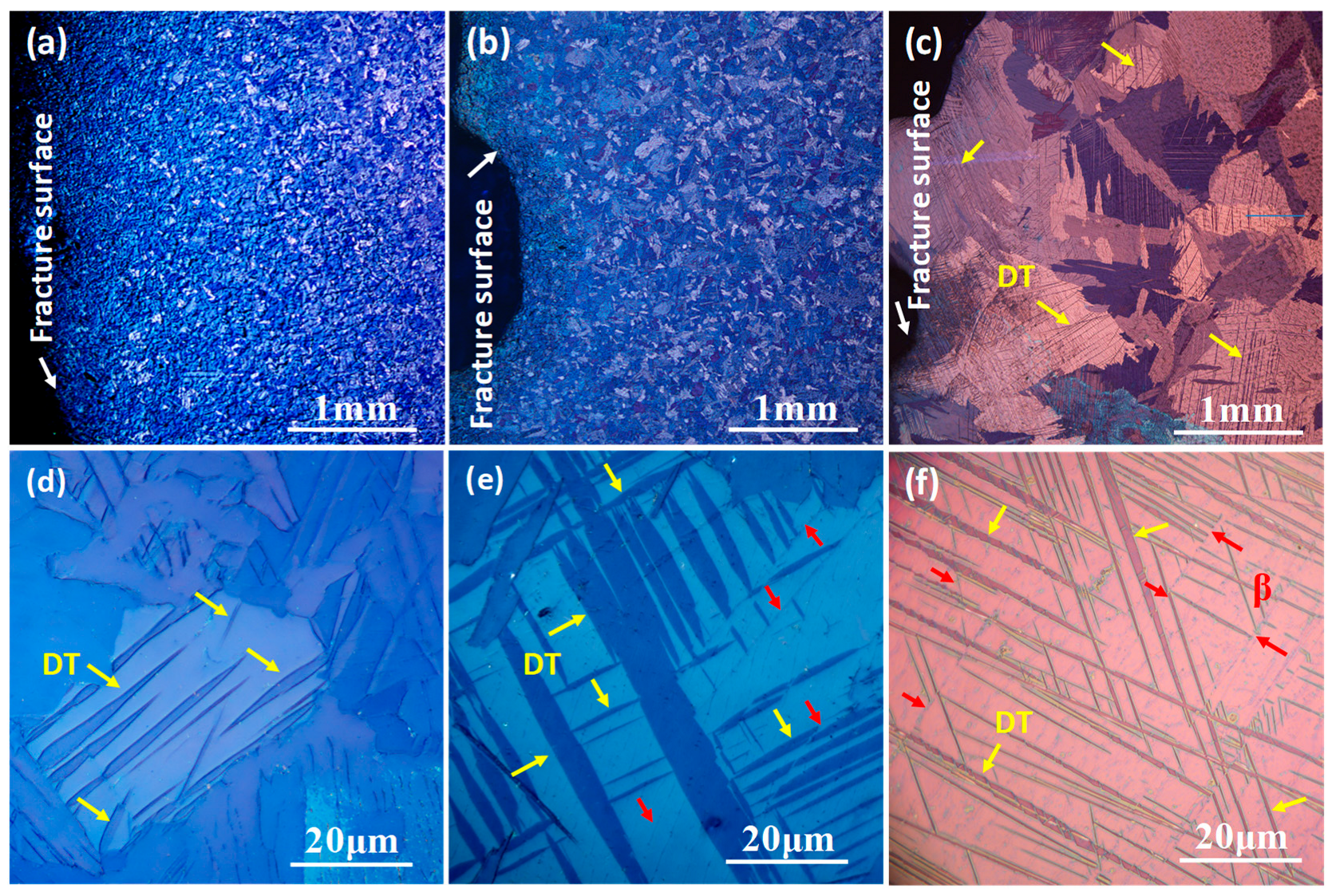
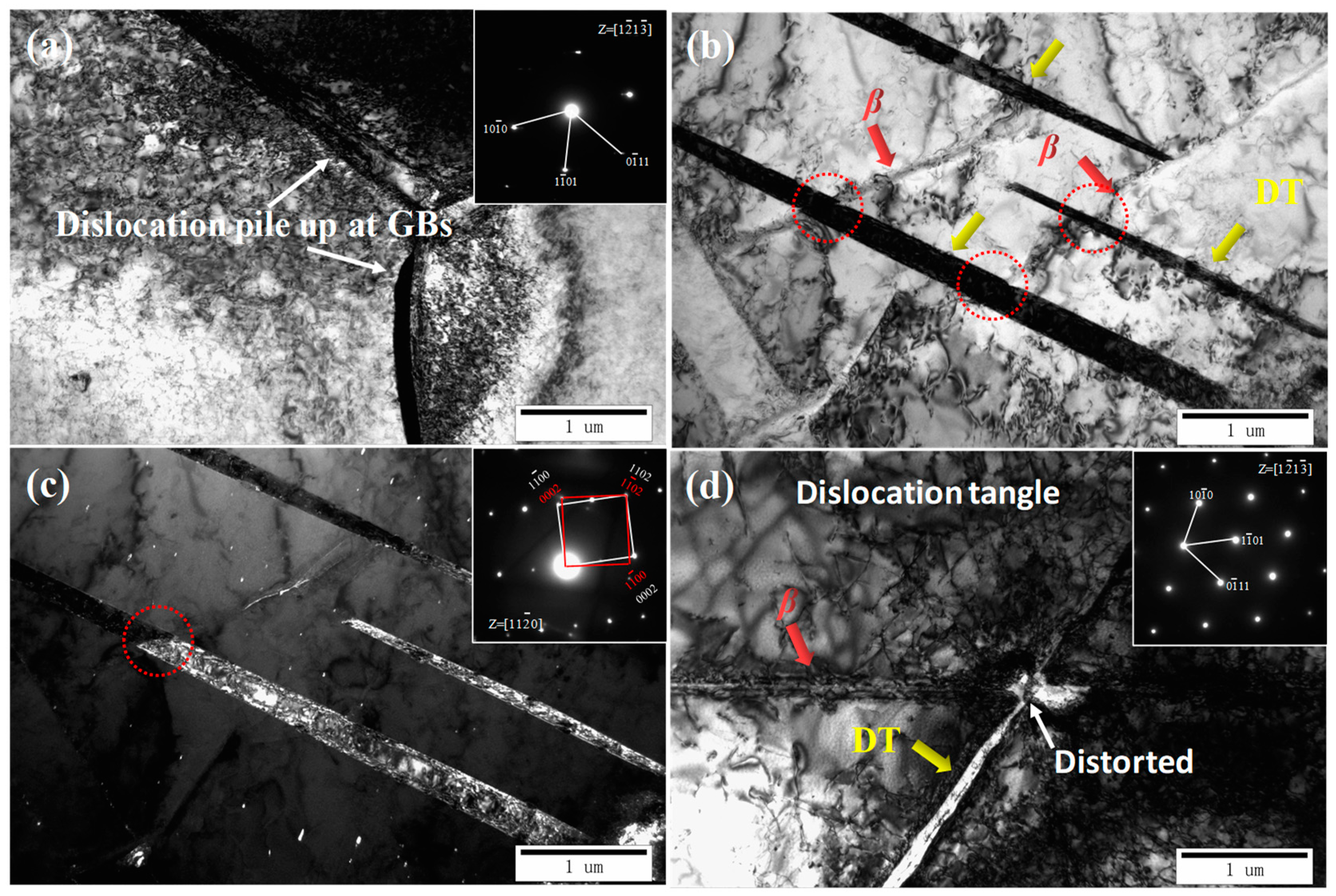
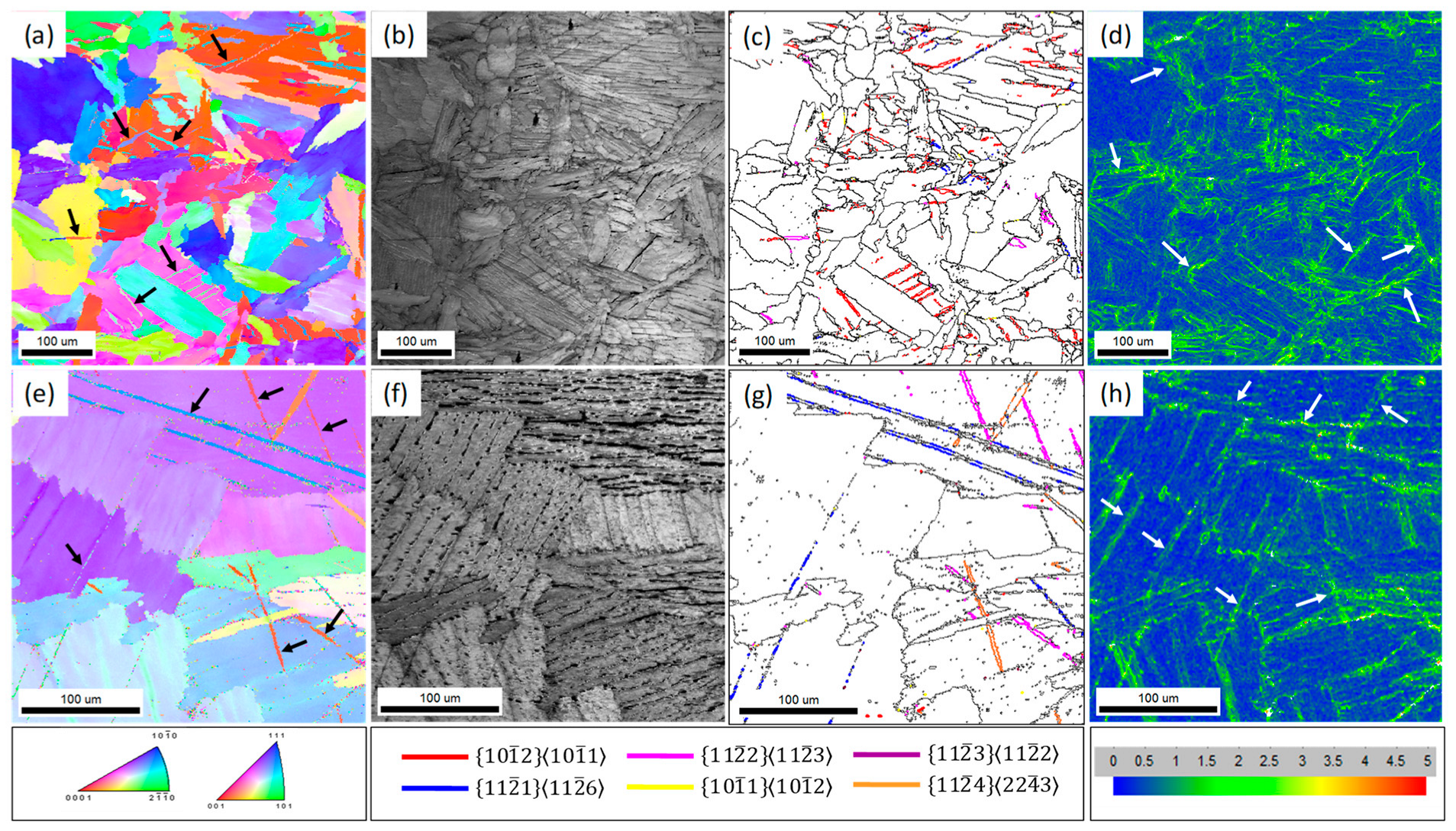
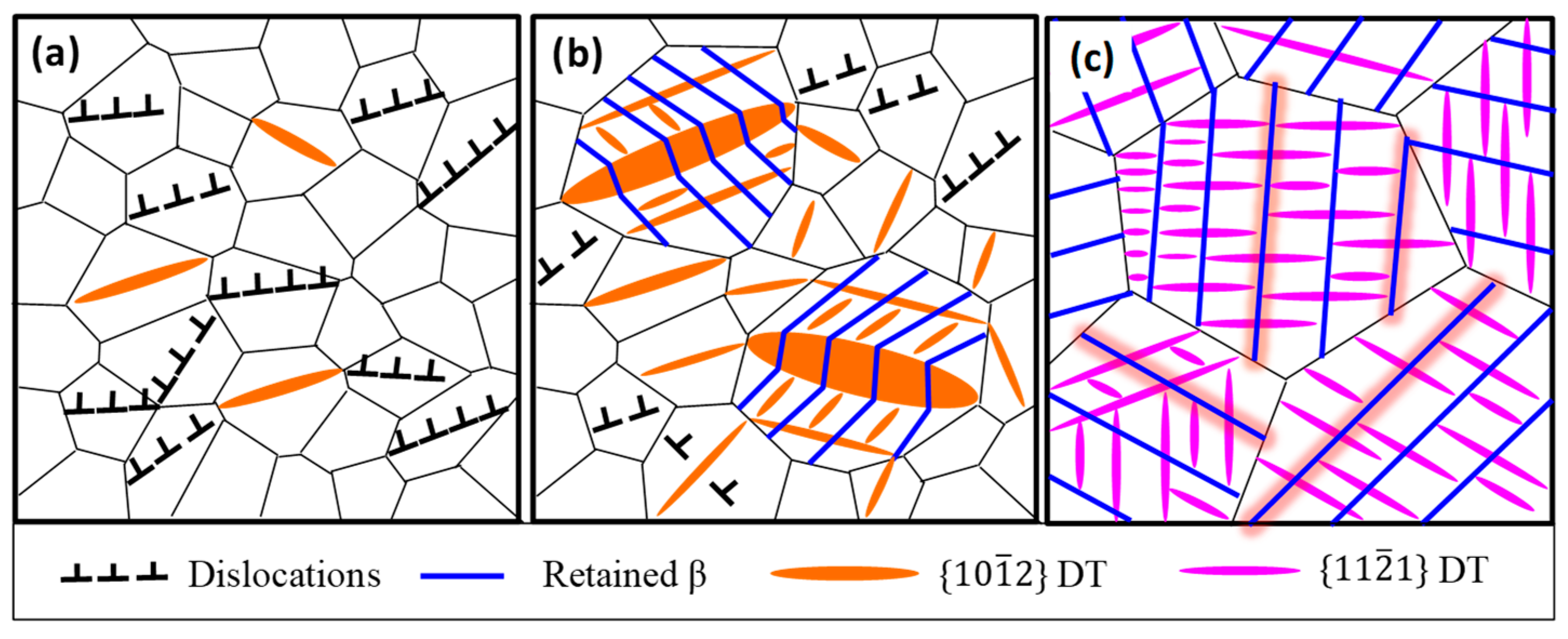

| FG Ti | MG Ti | CG Ti | |
|---|---|---|---|
| Yield strength (Rp0.2)/MPa | 479.82 | 541.28 | 525.92 |
| Elongation to failure (A)/% | 30.44 | 23.93 | 17.23 |
Publisher’s Note: MDPI stays neutral with regard to jurisdictional claims in published maps and institutional affiliations. |
© 2022 by the authors. Licensee MDPI, Basel, Switzerland. This article is an open access article distributed under the terms and conditions of the Creative Commons Attribution (CC BY) license (https://creativecommons.org/licenses/by/4.0/).
Share and Cite
Xin, C.; Wang, Q.; Ren, J.; Zhang, Y.; Zhang, L.; Sang, B.; Li, L. Influence of Grain Size and Its Distribution on Charpy Impact Properties of TA3 Alloy. Materials 2022, 15, 8537. https://doi.org/10.3390/ma15238537
Xin C, Wang Q, Ren J, Zhang Y, Zhang L, Sang B, Li L. Influence of Grain Size and Its Distribution on Charpy Impact Properties of TA3 Alloy. Materials. 2022; 15(23):8537. https://doi.org/10.3390/ma15238537
Chicago/Turabian StyleXin, Chao, Qi Wang, Junqiang Ren, Yonghong Zhang, Liang Zhang, Biao Sang, and Le Li. 2022. "Influence of Grain Size and Its Distribution on Charpy Impact Properties of TA3 Alloy" Materials 15, no. 23: 8537. https://doi.org/10.3390/ma15238537
APA StyleXin, C., Wang, Q., Ren, J., Zhang, Y., Zhang, L., Sang, B., & Li, L. (2022). Influence of Grain Size and Its Distribution on Charpy Impact Properties of TA3 Alloy. Materials, 15(23), 8537. https://doi.org/10.3390/ma15238537






